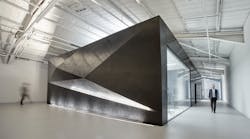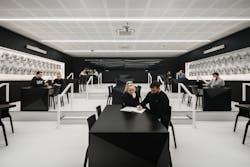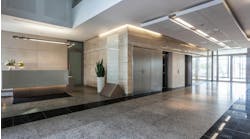Peek Inside an Immersive Learning Lab for Virtual Reality
VR, AR, AI and mixed reality—today’s university students need interactive classrooms that support the latest virtual technologies. These tools are essential to developing careers in everything from e-sports and game design to 3D modeling for automotive and healthcare equipment.
Take a peek inside the Extended Reality (XR) Lab, which is a hyperconnected learning environment.
From Engine Hangar to VR Studio
Imagine a space where students can learn on a VR headset, watch a guest lecture on a video wall or broadcast their motion capture in real time to a conference room. The XR Lab provides this and more to students and faculty under the Interactive, Immersive and Entertainment Technology program. The 3,230-square-foot facility is part of the Eastern Colleges Group’s University Studies located at West Suffolk College (UK). Designed by the firm WindsorPatania, it contains four connected environments: the Immersion Lab, Collaboration Theatre, Green Room and Conference Room.
The project’s first challenge was to convert an industrial hangar for engineering students into a high-tech environment. It wasn’t practical to retrofit the entire structure, so the WindsorPatania team settled on a self-contained pod.
“By having a building within a building, only the lab itself needs thermal insulation and regulation rather than the hangar’s entire envelope,” explained Ryan Windsor, development director and cofounder. “This approach makes the project’s carbon footprint much smaller. It also allowed us to complete design and build within nine months.”
Situated amid traditional classrooms and computer labs, the XR Lab offers a new environment for innovative learning. This meant embracing a bold design for the lab’s shell, which has the appearance of angular black metal.
“The college wanted the lab to be a conversation piece. They weren’t afraid of it looking like a futuristic spaceship. We were free to take inspiration from sci-fi movies like 2001: Space Odyssey and Men in Black,” said Giovanni Patania, architect director and cofounder, who has also created stores for Apple.
To find a material that didn’t need waterproofing or weatherproofing, the team turned to high-end interior design finishes. Polished plaster achieved a reflective surface with the illusion of texture.
“Everyone touches it—which is exactly what we wanted. It makes people feel like they can’t wait to get inside,” added Windsor. “The entire lab sparks curiosity, and that’s a precious reaction for an institution to foster.”
Technology Fluidity
Creativity and collaboration are infused into every corner of the lab. For example, a participant can produce stop motion footage that’s shared next door to classmates providing simultaneous feedback. One project used 3D design to envision more efficient pit stops for Formula 1 drivers. A multidisciplinary team of coding and environment design students already produced a multiplayer racing game.
While the XR Lab uses cutting-edge technology, the pace of obsolescence will necessitate continuous updates. Virtual reality is an explosively growing field, so the space will need new devices and software capabilities faster than a conventional computer lab. As tech evolves, the lab’s integrity won’t be impacted. This prompted practical design considerations, like the width of openings, height of video displays and flexibility for wired and wireless devices.
This level of futureproofing is essential because the space is available to use by industry partners as well. As the college advertises on its website, the XR Lab enables corporations to “develop an understanding of what XR can do for businesses and customers, upskill existing employees and develop tailored apprenticeship and training programs.”
“The XR Lab allows the college to provide a hub-and-spoke model for anyone to jump in, collaborate and share knowledge,” Patania explained. “It’s not just a building—it’s a movement.”



